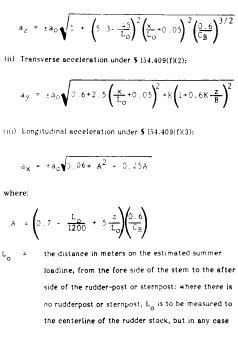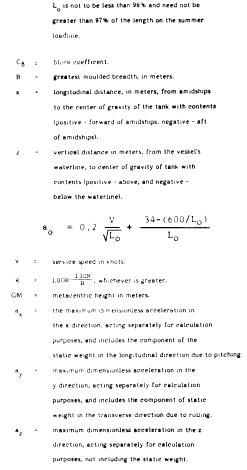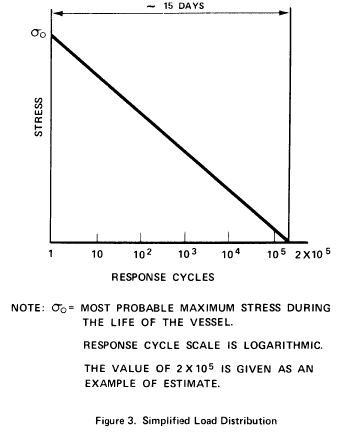Title 46
SECTION 154.409
154.409 Dynamic loads from vessel motion.
§ 154.409 Dynamic loads from vessel motion.(a) For the calculation required under § 154.406 (a)(3) and (b), the dynamic loads must be determined from the long term distribution of vessel motions, including the effects of surge, sway, heave, roll, pitch, and yaw on irregular seas that the vessel may experience during 10 8 wave encounters. The speed used for this calculation may be reduced from the ship service speed if specially approved by the Commandant (CG-ENG) and if that reduced speed is used in the hull strength calculation under § 31.10-5(c) of this chapter.
(b) If the loads determined under paragraphs (c), (d), or (e) of this section result in a design stress that is lower than the allowable stress of the material under §§ 154.610, 154.615, or 154.620, the allowable stress must be reduced to that stress determined in paragraphs (c), (d), or (e).
(c) If a tank is designed to avoid plastic deformation and buckling, then acceleration components of the dynamic loads must be determined for the largest loads the vessel may experience during an operating life corresponding to the probability level of 10−8, by using one of the following methods:
(1) Method 1 is a detailed analysis of the vessel's acceleration components.
(2) Method 2 applies to vessels of 50 m (164 ft) or more in length and is an analysis by the following formulae that corresponds to a 10−8 probability level in the North Atlantic:
(i) Vertical acceleration under paragraph (f)(1) of this section:


(d) If a cargo tank is designed to avoid fatigue, the dynamic loads determined under paragraph (a) of this section must be used to develop the dynamic spectrum.
(e) If a cargo tank is designed to avoid uncontrolled crack propagation, the dynamic loads are:
(1) Determined under paragraph (a) of this section; and
(2) For a load distribution for a period of 15 days by the method in Figure 3.

(f) When determining the accelerations for dynamic loads under paragraph (a) of this section, the accelerations acting in a cargo tank must be estimated for the cargo tank's center of gravity and include the following component accelerations:
(1) Vertical accelerations, meaning the motion acceleration of heave and pitch, and of any roll normal to the vessel base that has an effect on the component acceleration.
(2) Transverse acceleration, meaning the motion acceleration of sway, yaw and roll, and gravity component of roll.
(3) Longitudinal acceleration, meaning the motion acceleration of surge and pitch and gravity component of pitch.
[CGD 74-289, 44 FR 26009, May 3, 1979, as amended by CGD 82-063b, 48 FR 4782, Feb. 3, 1983]